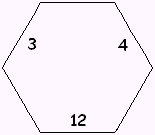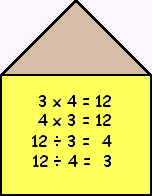| You can split your deck of fact family cards into two piles: facts you are learning and facts you know. Use the activities to build concepts to help you learn and picture new facts. Use the activities to build speed to get faster with the facts you already know.
* activities to build concepts
Egg Carton Math
Make a Rectangle
Make a Rod Train
* Egg Carton Math
Display the fact families using different sections of an egg carton to hold each group of objects.
You will need:
an egg carton
a plastic container with some type of small objects, such as:
pennies
beads
buttons
|
paper clips
dried beans
uncooked macaroni |
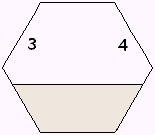 |
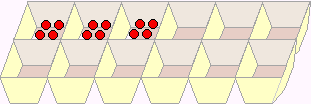 |
| Since we are only using one card for each fact family, the 3 and the 4 on this card can be read as "3 x 4" or "4 x 3." Think of 3 x 4 as "3 groups of 4." This egg carton shows 3 groups of 4 objects. After
the problem is set up, you can count by 4's: 4, 8, 12.
|
This egg carton shows
4 x 3 ...
4 groups of 3 objects. |
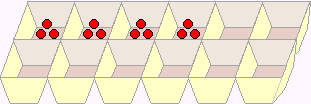 |
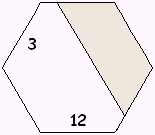 |
 |
| 3 groups of what make 12? Count out 12 small objects into 3 of the sections (the way you might deal cards to 3 people). How many objects are in each section? (4) Count by 4's to check: 4, 8, 12. |
 |
 |
| If you like, you may think of the same card this way: How many groups of 3 make 12? Count out 12 small objects, placing 3 in each section. How many sections are there? (4) Count by 3's to check: 3, 6, 9, 12. |
 up up
* Make a Rectangle
Make an array to show each fact by coloring rectangles on graph paper.
You will need:
graph paper
colored pencils, crayons or markers
(optional) Cuisenaire rods
(optional) multiplication table

You can think of this card as 3 x 4 or 4 x 3.
|

3 x 4 = 12
3 groups of 4 = 12
|

4 x 3 = 12
4 groups of 3 = 12 |
|
You can compare the two rectangles and see that both
have 12 squares.
You can also make rectangles with Cuisenaire rods. This way the colors also help to reinforce the problems. If you don't have Cuisenaire rods, you can color and cut out strips of centimeter graph paper to use in the same way. Store them in an envelope or a plastic zippered bag.
The colors are:
|
1: white |
 |
6: dark green |
 |
| 2: red |
 |
7: black |
 |
| 3: light green |
 |
8: brown |
 |
| 4: purple |
 |
9: blue |
 |
| 5: yellow |
 |
10: orange |
 |
Make a multiplication table, using the same size of graph paper. Place the
numbers 1 - 10 running down the left side and running across
the top, with a multiplication sign in the top left corner.
Draw 2 thicker lines to separate out the answers.
Fill in the answers carefully. (At least fill in the products for the facts you are learning.)
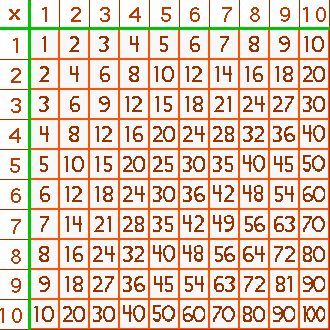
Here are 3 x 4 and 4 x 3 (with the
grid numbers covered by the rods shown):

3 x 4 = 12 (3 groups of 4 = 12) |

4 x 3 = 12 (4 groups of 3 = 12) |
To show 3 x 4, think: 3 groups of 4. Lay 3 purple rods on the multiplication grid, starting at the top left corner of the answer area. Then peek under the
bottom right corner of the rectangle. You should find a
12 there. To show 4 x 3, think: 4 groups of 3. Lay 4 light green rods in the same way and peek under the bottom right
corner. Again you should find a 12.
 up up
* Make a Rod Train
 |
Lay Cuisenaire rods (or paper strips) of the same color along a centimeter ruler to
show multiplication as repeated addition. For 3 x 4, you
would lay 3 purple rods end to end and see that they have
reached 12 on the ruler.
 |
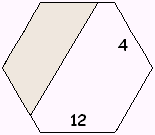 |
You can use the same rod train to show division: How many groups of 4 make 12? (3) |
 up up
* games and activities to build speed
These activities are meant to be used only after you have become very familiar with each card, using some of the ideas in the activities to build concepts section above.
Shrinking Time Limit
Hide Two
3-Minute Sort
Four Facts in the Family
* Shrinking Time Limit
Ask a partner to time you as you answer each card. Agree on a time limit. You might start with 10 seconds per card. If you answer a card correctly within the time limit, set it aside and go on to the next card. If you cannot answer the card correctly within the time limit, take all the time you need to figure it out, using objects or skip-counting. Then explain out loud how you solved the problem. Set these harder cards in a different pile as you answer each one. After you finish going through the stack, return to the pile of harder cards (which took you longer to answer). Repeat the steps above with the same time limit, seeing which harder cards you can now answer within the time limit, and taking as much time as you need to figure out the others and explain how you figured them out.
When you are able to go through the whole pile within your time limit, set a shorter time limit and repeat the steps above. Eventually your goal is to answer each card in 3 seconds or less!
 up up
* Hide Two
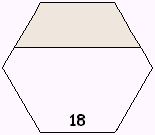
2 x 9
3 x 6 |
Set the roof on your "house" so that the top two numbers of each card are hidden. Have a partner time you for 10 seconds while you say or write the pairs of numbers which might be hidden. Remember that the top two numbers are always single digits. The possible hidden pairs for this card are listed below it. (In this activity, the order of the two numbers doesn't matter. If you say "9 x 2" and the card has 2 on the left and 9 on the right, that is still fine. So you only need to mention each combination of numbers once.) For some cards, there is only one possible solution.
|
When the 10 seconds are up, look at the whole card. If you had said or written the pair of missing numbers (in either order), you keep the card. Otherwise, your partner keeps the card. Now it is your partner's turn to guess the missing numbers on the next card while you do the timing. This game is partly skill and partly luck. But the better you know your facts, the faster you'll be able to say all of the possible pairs of hidden numbers, and you'll have a better chance of keeping your cards.
 up up
* 3-Minute Sort
Place the cards in the fact family house, covering any of the 3 numbers on the cards. Use a 3-minute timer and see how many cards you can get through in three minutes, saying the missing number on each card before you lift it from the house. If you are correct, place the card in one pile. If you are wrong or can't answer, place the card in another pile. When the three minutes are up, count how many cards are in each pile. Now place the fact family house so that it covers a different portion of each card, and time yourself again. Can you get through more cards in the stack this time?
 up up
* Four Facts in the Family
For this activity, you don't need the fact family house. Look at each card and write the four facts in that fact family. (You can draw a house for each set of facts and write the facts inside of it if you like.)
You can do this as an untimed activity or see how many cards you can get through in a certain time.
 up up
How to use the x ÷ cards
print the x ÷ cards
addition / subtraction cards
|




 up
up

 up
up





















